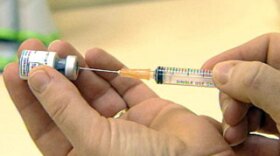Governor Roy Cooper extended North Carolina's stay-at-home order until at least May 8. The order was issued to slow the spread of the coronavirus.
This means the social distancing measures in place since March 30 will continue. Those include the mandated closures of restaurants for dine-in service and bars, along with the closure of other close-contact businesses.
Cooper also outlined plans for phasing in businesses that could open once the order is lifted. That would include allowing some businesses to open, and to allow people to leave their houses for certain commercial activity not allowed under the order.
At the daily COVID-19 briefing, Cooper said he wants to allow businesses to operate again, but that the "health and safety of people in North Carolina must be our top priority." He explained that the phasing in plan offers a guide to "begin easing restrictions in stages to push our economy forward."
During the briefing, N.C. Health and Human Services Secretary Dr. Mandy Cohen gave specifics around contact tracing, testing, hospitalizations and other metrics that would define when Cooper allows the state to enter Phase 1 of the reopening. The stay-at-home and other orders were extended because North Carolina has not yet seen a downward trajectory of those metrics needed to begin gradually lifting restrictions, according to Cooper.
"North Carolina cannot stay at home indefinitely," said Cooper. "We have to get more people back to work. Right now, the decision to stay at home is based on the public health data and White House guidance. North Carolina needs more time to slow the spread of this virus before we can safely begin lifting restrictions. I know that this pandemic has made life difficult for many people in our state and I am focused on keeping our communities safe while planning to slowly lift restrictions to help cushion the blow to our economy."
According to the Governor's plan, in order to begin lifting restrictions the state must see progress in key metrics including:
- Sustained Leveling or Decreased Trajectory in COVID-Like Illness (CLI) Surveillance Over 14 Days. Currently, North Carolina's syndromic surveillance trend for COVID-like illness is decreasing over the last 14 days.
- Sustained Leveling or Decreased Trajectory of Lab-Confirmed Cases Over 14 Days. Currently, North Carolina's trajectory of lab-confirmed cases over the last 14 days cases is still increasing, although at a slower rate.
- Sustained Leveling or Decreased Trajectory in Percent of Tests Returning Positive Over 14 Days. Currently, North Carolina's trajectory in percent of tests returning positive over the last 14 days is increasing at a slow rate.
- Sustained Leveling or Decreased Trajectory in Hospitalizations Over 14 Days. Currently, North Carolina's trajectory of hospitalizations over the last 14 days is largely level with a slight trend upward.
The plan outlines that on top of these metrics, "the state will continue building capacity to be able to adequately respond to an increase in virus spread." These steps include:
- Increase in Laboratory Testing. Currently, North Carolina is testing approximately 2,500 to 3,000 people per day and is working to increase to at least 5,000 to 7,000 per day.
- Increase in Tracing Capability. Currently, North Carolina has approximately 250 people doing contact tracing across its local health departments and is working to double this workforce to 500.
- Availability of Personal Protective Equipment. The state is working to ensure there are adequate supplies to fulfill requests for critical PPE for at least 30 days. This includes face shields, gloves, gowns, N95 masks, and surgical and procedural masks. Currently the state has less than 30 days supply of gowns and N95 masks. Availability of PPE is calculated based on the average number of requests for the last 14 days compared to the supply that the state has on hand.
Copper outlined a three-phase plan to re-open the economy while also preventing hot spots of contagion. He noted that this three-stage plan could shift as more information becomes available.
In Phase 1:
- Modify the Stay At Home order allow travel not currently defined as essential allowing people to leave home for commercial activity at any business that is allowed to be open, such as clothing stores, sporting goods stores, book shops, houseware stores and other retailers.
- Ensure that any open stores implement appropriate employee and consumer social distancing, enhanced hygiene and cleaning protocols, symptom screening of employees, accommodations for vulnerable workers, and provide education to employees and workers to combat misinformation
- Continue to limit gatherings to no more than 10 people
- Reopen parks that have been closed subject to the same gathering limitation. Outdoor exercise will continue to be encouraged.
- Continue to recommend face coverings in public spaces when 6 feet of distancing isn't possible
- Encourage employers to continue teleworking policies
- Continue rigorous restrictions on nursing homes and other congregant care settings
- Local emergency orders with more restrictive measures may remain in place.
Phase 2 - At least 2-3 weeks after Phase 1
- Lift Stay At Home order with strong encouragement for vulnerable populations to continue staying at home to stay safe
- Allow limited opening of restaurants, bars, fitness centers, personal care services, and other businesses that can follow safety protocols including the potential need to reduce capacity
- Allow gathering at places such as houses of worship and entertainment venues at reduced capacity
- Increase in number of people allowed at gatherings
- Open public playgrounds
- Continue rigorous restrictions on nursing homes and other congregant care settings
Phase 3 - At least 4-6 weeks after Phase 2
- Lessen restrictions for vulnerable populations with encouragement to continue practicing physical distancing and minimizing exposure to settings where distancing isn't possible
- Allow increased capacity at restaurants, bars, other businesses, houses of worships, and entertainment venues
- Further increase the number of people allowed at gatherings
- Continue rigorous restrictions on nursing homes and other congregant care settings









